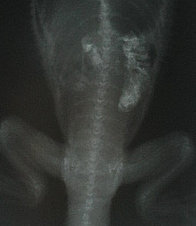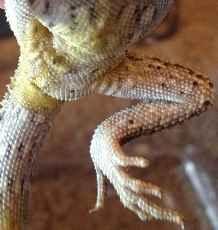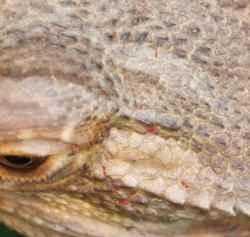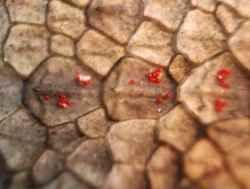If your Dragon is not getting adequate UVB lighting, adding more calcium may not be the solution. UVB light causes vitamin D to be produced in the skin of the bearded dragon. Vitamin D3 is required for calcium metabolization, which allows calcium absorption into the body via the digestive tract.
A UVB light is an essential part of keeping a bearded dragon. They are available at most pet stores and must be updated every 6 months.
When looking for calcium, make sure it is specific to a bearded dragon care supplement; if you are unsure, seek guidance from a veterinarian.
A rich fiber diet will bind to calcium. This is why you should keep your beardie away from Lettuce. Although lettuce is low in fiber, excessive ingestion will bind to calcium, rendering it indigestible.
Low temps can also be the culprit. Bearded Dragons need the right temps to digest. Make sure to check basking temps from time to time. 100-105 for babies and 105-110 for adults but staying within the 100-110 range should be fine for baby bearded dragon care.
Most Metabolic Bone Disorders can be cured after the underlying reasons are addressed.
- Maintain minimum basking temperatures of 95 degrees.
- Calcium coat feeder insects should be fed once a day for newborns and twice a week for adults.
- Give calcium supplements
- Never feed your bearded dragon lettuce or other high-fiber greens.

CT Scan Of Impaction In Beard Dragon
Impaction occurs when your Bearded Dragon consumes something that cannot be digested, causing a blockage of the intestinal tract. Impaction will result in death if left untreated.
Impaction symptoms can be difficult to recognize. In elder bearded dragons, this is frequently confused with Brumation. It should be relatively easy to spot.
Symptoms that could indicate impaction There are no bowel movements. Bloated and hard stomach, lethargy, appetite loss, and inability to move back legs
Proper husbandry is essential for preventing not just impaction but practically all diseases, one of which is housing and proper substrates.
The majority of impaction occurrences are caused by poor substrate, particularly in infants. Never line your enclosure with anything other than paper towels, newspaper, or reptile carpet.
I've seen folks utilize shattered sea shells as substratum previously, as well as sand, chips, pebbles, and small rocks. What a terrible idea! , your dragon may intentionally or accidentally consume substrate fragments, resulting in impaction. Maintain simplicity and safety!
Remember, never feed large and indigestible food. the food should be no longer than the space between its eyes, Use common sense, If it looks too big for your beard dragon, it probably is.
Cold temperatures or poor basking conditions. You may notice that once your dragon has finished eating, he or she immediately begins basking.
To digest their meal, dragons must bask and keep their bodies warm. Impaction will occur if the basking temperature is too low. Your bearded dragon won't be able to digest anything.
Impaction can sometimes be treated at home. Correct basking temperatures as needed. Massage the belly gently from top to bottom, moving undigested food out of the system.
Warm baths and massages on a regular basis.
A few drops of olive oil can be used as a safe laxative.
If you've been seeing impaction symptoms in your bearded dragon for a while. Furthermore, if you have been using a dangerous substrate, such as pebbles, and suspect ingestion, consult a veterinarian. Surgery is sometimes the only option.
A pathogenic parasite is an organism that lives on or in the host and feeds on or at the expense of the host. In captivity, parasite infestations are frequently severe due to overcrowding, poor husbandry, and stress. A veterinarian should examine any reptile that exhibits signs of loss of appetite, weight loss, or loose bowel movements.
The list below gives a brief description of the most common parasite infestations in Bearded Dragon.
Cryptosporidiosis is a significant protozoal parasite. This parasite spreads by the oral-fecal pathway. Because the parasite is robust and resistant to most conditions, it can still be contracted through surfaces. Symptoms include a severely enlarged stomach, diarrhea, body wasting, and weakness.
Isospora Amphiboluri is a parasite spread by oral-fecal transmission. The majority of reptiles with compromised immune systems die as a result of multi-organ failure. Anorexia, lethargy, and diarrhea are among the symptoms.
Pinworms are not harmful because the symptoms are moderate and controllable, and they are thought to help the digestive system. There are no long-term negative effects, nor are there any severe symptoms. Pinworms can cause stomach irritation, loss of appetite, and weight loss in high numbers and must be treated.
Keep your hands clean by washing or sanitizing them before and after handling your bearded dragon. You can easily infect your beardie with a sickness.
On the other hand, it may also transfer a bug to you! Salmonella can be carried by reptiles without causing symptoms.
Keep your bearded dragon's enclosure clean. Never feed baby bearded dragons insects that you have caught in the wild. It may appear to be a wonderful idea, but it is unclean. Who knows what a wild bug might be carrying? Don't take the risk, consider the potential Veterinarian fees if you're contemplating doing it to save money.
Feeder insects should only be obtained from a reputable source. The majority of parasites are transmitted by bad-feeding insects. You may decide to raise your own crickets at some point. To be honest, that's your best bet. If you have the time, resources, and a strong attachment to your dragon.
Maintain a clean tank or enclosure. Every day, remove or clean any contaminated substrate. Weekly disinfect your dragon's cage. Confirm that you know how to sterilize the tank or enclosure. Clean the area around your enclosure.
The only true way to rid your Bearded Dragon of parasites is to consult a veterinarian. The veterinarian will be able to prescribe the appropriate medications. Also, even when the symptoms have subsided, disinfect the cage more frequently. At least for a week or two. This will keep it from happening again.

Bearded Dragon Mouth Rot
All reptiles are susceptible to mouth rot. Mouth rot, if left untreated, can cause a variety of health issues, ranging from tooth loss to digestive problems and even lung infections.
Fortunately, the early indicators of mouth rot are obvious.
Infectious Stomatitis (mouth rot) causes the inside of the mouth to turn red and puff up somewhat. After a while, the inside and outside of the mouth will be yellow. This can cause pus to seep from the mouth and nose, as well as dead tissue inside the mouth.
Stress factors can impact negatively your dragon's immune system. Improper handling, relocating to a new cage, low enclosure temperatures, extreme temperature gradients, or poor nutrition are all examples of stress factors.
When combined with a mouth injury, Infectious Stomatitis takes hold
Maintain basking temperatures of 100-110 degrees Fahrenheit and do not allow cool parts to go below 85 degrees Fahrenheit.
Keep your bearded dragon environment simple and secure. Use a decent substrate, a simple basking log or rock, and make sure there are no sharp or jagged edges in the cage.
It's possible, but rare, that your dragon might injure its mouth while catching its prey. So be careful what you feed your dragon.
You need to take your bearded dragon to the veterinarian. There are no effective home cures or treatments available. The doctor will likely prescribe penicillin or some type of oral treatment.
Tips!- Maintain a consistent environment for your infant bearded dragons. They are unable to deal with the stress.
- The enclosure must be clear of anything that they could bite or chew and cause harm to the mouth

Yellow Fungus Disease is a potentially lethal and rapidly spreading disease that enters the dragon's skin and tissue and directly decomposes and consumes the tissue. Bearded Dragons infected with yellow fungi are likely to die, especially if not caught right away.
The exact origin of the yellow Fungus is uncertain. This fungus is assumed to be the source of naturally occurring disease, it is present in the environment (e.g., soil, cage substrates), and the factors regulating its severity for captive reptiles remain unclear. Although poor nutrition, poor husbandry, and environmental stressors can all contribute animals to illnesses.
The first sign of Yellow fungus is a change in the behavior of your Bearded Dragon. Lethargy and loss of appetite will become apparent when he or she becomes ill. Yellow patches can appear anywhere on the body. Appendages that are swollen or necrotic may change color from red to green, yellow, or black. Blisters can swell and fill with pus. Necrotic tissue darkens, indicating death. This has the ability to spread fast throughout the limbs.
If you suspect yellow fungus in your bearded dragons, remove them from the enclosure as soon as possible. Put the Beardie in a separate enclosure. Thoroughly clean and sterilize the clutch enclosures or tank and the surrounding area.
Take your sick Dragon to the vet as soon as possible. After an examination, your veterinarian may opt to treat your dragon with itraconazole and other powerful antifungal medications.
Tips!Respiratory Infection
Respiratory illnesses, which can be bacterial, viral, or fungal in nature, are quite common in bearded dragons and are often the result of inadequate habitat setup, insufficient temperatures or nutrition, or poor husbandry.Failed equipment, such as a defective basking bulb or a heater thermometer that has broken, could possibly be the cause. Remember that your young bearded dragons will require the proper surroundings to thrive.
The temperature gradient in the must is between 75 and 110 degrees Fahrenheit. Temperatures in the basking area should be between 100 and 110 degrees Fahrenheit. Humidity levels should never exceed 50%.
The enclosures must have free-flowing air. Never close the top of your bearded dragon's tank or enclosure. Air must be allowed to enter and exit the cage.
A change in behavior, gasping or rattling sound when breathing, and mucus oozing from the nose and mouth are all symptoms of respiratory tract infections.
If detected early, it is treatable at home. Temporarily boost temperatures above normal. Maintain a healthy food for your bearded dragon and supplement it with calcium. If the symptoms have persisted for a week or more, consult a veterinarian. A straightforward antibiotic course may be prescribed. Taking proper care of your pogona vitticeps may protect you from developing the condition.

Bearded Dragon With Mites
Mites are transmitted to bearded dragons through other lizards or infested locations.
Mites are common in breeders and pet stores that do not maintain clean enclosures. Mites are tiny, almost microscopic bugs that cling to and feed on your Pogona.
They lay sticky clusters of eggs, usually in between or near the scale's border.
You should be able to see them with your own eyes, despite their little size. Colors are frequently vivid red or brown.
When affected, a Bearded dragon will commonly remain close to its water dish and ich. Your Beardie may not exhibit any symptoms of infection. When handling your bearded dragon, check it.

Mites are easily prevented and treated, though treatment can take time. If you find mites on your bearded dragon, relocate him or her to a temporary enclosure.
Soak and wipe the spikes of your dragon with Betadine or a commercial reptile mite treatment. Repeat for approximately a week.
Everything should be cleaned and treated. Replace the substrate a few times during the week. You must continue therapy until you are certain that no mites remain.
Clean and treat everything. Replace substrate a few times for that week. You must continue treatment until you are confident no trace of mites is left.
- Examine bearded dragons before putting them in an enclosure.
- Avoid using shared enclosures or tanks.
- Do not assume that a recently purchased dragon is mite-free. Inspect and carefully select your newborn bearded dragon.
- Inspect your dragon on a regular basis. Mites are little but noticeable.
- If infected, disinfect everything, including your bearded dragon, until all traces of infection have disappeared.
Tail rot is common in Baby Bearded Dragons that live in groups. Baby pogona may bite or nip at each other's tails when in groups.
This behavior could be a sign of another sickness or malnutrition. Tail rot can occur if something falls on or cuts the tail, or if your dragon does not completely shed the tail skin.
Tail rot can be caused by any trauma or damage.
Tail rot is easily identifiable. When circulation is disrupted or restricted, tail rot occurs.
The tip of the tail may turn black, indicating the presence of dead tissue. This can also work its way up the tail. If left untreated, your bearded dragon may lose a portion of its tail. Tail rot is quite simple to treat and may be avoided by bathing your Pogona on a regular basis. Once infected, hydrogen peroxide can be used to treat the region.
This will aid in the removal of the infection. Bathing on a regular basis will aid in the removal of dead skin. You can also gently assist your dragon with the shedding process.
- Bathe your dragon on a regular basis when it is shedding.
- Assist with shedding on the tail
- Attempt to avoid tail injury
- On affected regions, apply hydrogen peroxide.
- Now that you have a list of Baby Bearded Dragon diseases, be sure to share it!
Conclusion
Finally, the major cause of reptile sickness is poor husbandry. Proper care should be taken to reduce the chances of your bearded dragon becoming ill or infected.
Your regimen should involve regular observation of your bearded dragon, since the earlier, they are caught, the better their chances of recovery, and hygiene. Remember that parasites like salmonella can be transmitted to humans.
Some illnesses and diseases are lethal if left untreated; get veterinary advice if you are unsure what action to take.
The vast majority of illnesses and diseases can be avoided. Prevention is better than cure!!
